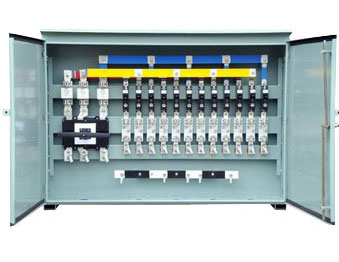Air Break Switch (11 / 33 KV)
Air Break Switch Disconnections are a vital part of any overhead line network, providing crucial points of isolation. Most overhead line networks are designed so that when a fault occurs or maintenance work needs to be carried out it is relatively simple, by means of a systematic series of switching operations, to isolate a certain section of overhead line. When this switching process is carried out it is absolutely imperative that the Air Break Switch Disconnector is reliable and effective.
Types of AB Switch
Air break switches can be of two types
- Single Pole/Three Pole Air Break Switch
- Gang Operated Air Break Switch
Air Break Switches are special switches designed isolate a circuit. They are usually employed in outdoor installations. Special Arcing Horns are provided to quench the arc which occurs when the current is interrupted. These switches are usually operated by a handle which is located at the ground level. Their operation can also be mechanized.
Earthing Switches
Earthing switches are safety devices which are integral parts of circuit breakers. When a circuit breaker is removed and racked out, the sections of the bus bar adjacent to the circuit breaker are automatically earthed by means of these switches.
This protects the maintenance personnel from accidental voltages. The closing action of the earthing switch is of snap action type. Earthing switches are usually dimensioned to withstand short circuit currents. Earthing switches can also be motorised.
Earthing switches are usually used in conjunction with isolators. When the isolator isolates the circuits, the earthing switches make contact with the busbar and discharge any charges which may have accumulated there.
Isolators (11 to 220 KV)
Isolator is a mechanical switch which isolates a part of circuit from system as when required. Electrical isolators separate a part of the system from rest for safe maintenance works.
Isolator is a manually operated mechanical switch which separates a part of the electrical power. Isolators are used to open a circuit under no load. Its main purpose is to isolate one portion of the circuit from the other and is not intended to be opened while current is flowing in the line. Isolators are generally used on both ends of the breaker in order that repair or replacement of circuit breaker can be done without and danger.
Types of Electrical Isolators
There are different types of isolators available depending upon system requirement such as
- Double Break Isolator
- Pantograph type Isolator
Drop Out Fuse (11 / 33 KV)
The Drop Out Fuse is an expulsion type and its main function is to protect Transformers on rural distribution network. It is also particularly useful for inaccessible Sub-stations where indication of fusing is of advantage.
Horn Gap Fuse (11 / 22 / 33 KV)
We manufactures Horn Gap Fuse set which are used in over head power line and used along with electrical Air Break Switches. The design of HG Fuse set is depends on their uses and application.
Types of Electrical Horn Gap Fuse
There are different types of Horn Gap Fuse available depending upon system requirement such as
- Solid Core.
- Pin Type.
- Post Type.
LT Distribution Box / ACDB / DCDB (Single Phase / Three Phase, 10 Kva – 500 Kva)
We manufactures a wide assortment of LT Distribution Box for 10Kva-500Kva transformers. The offered product is used in overhead transmission line with transformers for controlling flow of electricity and is also used for monitoring of the variations in voltages.







